Stealing Shipboard Firefighting Tactics (Eductors) for an Alternative Water Supply *UPDATED*
Stealing tactics and equipment used in shipboard firefighting, we can use the same eductor that is used to de-water shipboard firefighting water (prevents the boat from capsizing) to draft water out of a backyard swimming pool. I've done it and it works really well. Of course this eductor is considerably larger and heavier than the one shown in the video. But the output makes it a great tool to put in the box. All water tenders should have one of these.
Update: Thank's to Engineco613, a prior discussion about a commercially available water eductor called the TurboDraft can be accessed by clicking here.
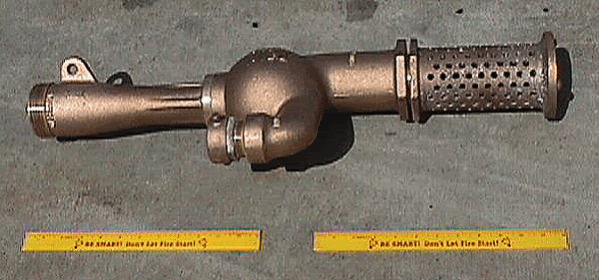
When you use the eductor to get water out of a swimming pool, you have to keep in mind that your are limited to about 200-feet maximum hose lay from the engine based on that being the standard lateral load that is used in the evolution.
Click this link to get a more descriptive step by step explanation of this new concept, (or at least I think it's new because I've never heard anyone else talk about it)... Swimming Pools and Water Eductors
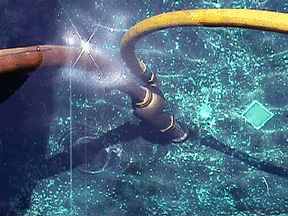
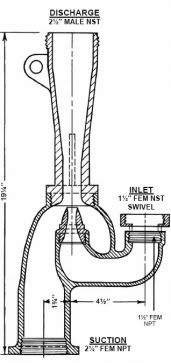
Manufacturer Suggested Uses – Fire Departments
1. Wild land Structure Protection
2. Drafting water from remote water supply
3. Dewatering basements, boats, tanks, etc.
4. Refilling Strike team
Manufacturer Suggested Uses – Marine Departments
1. Keeping bottoms dry during tank or hold washing operations.
2. Pumping water out of holds during firefighting operations.
3. Regular or emergency pumping of liquids or liquids with suspended particles from ballast, bilge, cargo spaces, pits, etc.
L.A. County Fire Department Model furnished with:
» Discharge Coupling as shown 2½” NST Male
» Inlet Coupling 1½” NST “F” swivel
» Non Return Flapper Type Check Valve
» Suction Strainer – Barrel type
S-Type Eductor Tip 000
About the 1 1/2-Inch (S-Type) Eductor
NSN 4320-00-217-0938
(Eductor, 1 1/2 In, 1 1/2 In Inlet X 2 1/2 In outlet)
Description
The 1 1/2-inch eductor is fabricated from a highly durable bronze metal and is made in the shape of an off-set half “U.” It is designed with a 1 1/2-inch NPSH swivel water inlet, a 2 1/2-inch male NH water discharge connection with a foot valve, a 2 1/2-inch suction opening at the bottom and an attached strainer.
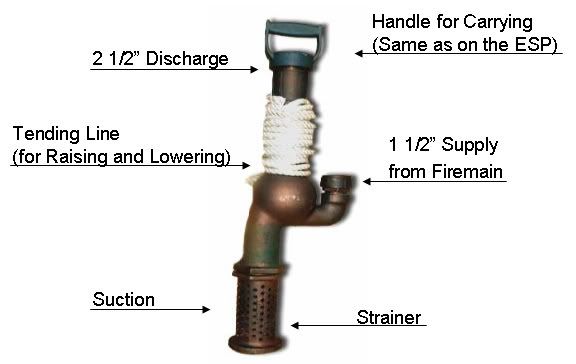
This eductor is used to pump out areas with small volumes of water. With a 100-psi, 125-gpm water supply, the eductor will pick up 100 gpm, for a net discharge of 225 gpm. It can be activated by water from the firemain, submersible pump or P-100 pump. If more than two 1 1/2-inch by 50-foot hoses are used on the actuation line, the eductor will be ineffective due to friction loss.
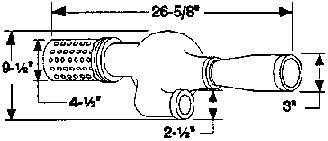
The eductor is shown with the nylon handling line. This line is used when lowering or lifting the eductor during dewatering operations. A 2 1/2-inch cap with a handle aids in carrying the eductor and protecting the male hose threads. The eductor is 26 5/8 inches long and weighs 20 pounds. It is contained in the dewatering equipment kit.
Note: The lighter and more efficient Derbyshire aluminum 1 1/2-inch eductor (NSN 9C 4320-01-110-0299) is being phased in to replace the heavier, less efficient bronze eductors.
"It's all about being able to go home in the morning..."
Mike Schlags, Fire Captain
Santa Barbara County Fire Department
mschlags@yahoo.com
Update: Thank's to Engineco613, a prior discussion about a commercially available water eductor called the TurboDraft can be accessed by clicking here.

When you use the eductor to get water out of a swimming pool, you have to keep in mind that your are limited to about 200-feet maximum hose lay from the engine based on that being the standard lateral load that is used in the evolution.
Click this link to get a more descriptive step by step explanation of this new concept, (or at least I think it's new because I've never heard anyone else talk about it)... Swimming Pools and Water Eductors


Manufacturer Suggested Uses – Fire Departments
1. Wild land Structure Protection
2. Drafting water from remote water supply
3. Dewatering basements, boats, tanks, etc.
4. Refilling Strike team
Manufacturer Suggested Uses – Marine Departments
1. Keeping bottoms dry during tank or hold washing operations.
2. Pumping water out of holds during firefighting operations.
3. Regular or emergency pumping of liquids or liquids with suspended particles from ballast, bilge, cargo spaces, pits, etc.
L.A. County Fire Department Model furnished with:
» Discharge Coupling as shown 2½” NST Male
» Inlet Coupling 1½” NST “F” swivel
» Non Return Flapper Type Check Valve
» Suction Strainer – Barrel type
S-Type Eductor Tip 000
About the 1 1/2-Inch (S-Type) Eductor
NSN 4320-00-217-0938
(Eductor, 1 1/2 In, 1 1/2 In Inlet X 2 1/2 In outlet)
Description
The 1 1/2-inch eductor is fabricated from a highly durable bronze metal and is made in the shape of an off-set half “U.” It is designed with a 1 1/2-inch NPSH swivel water inlet, a 2 1/2-inch male NH water discharge connection with a foot valve, a 2 1/2-inch suction opening at the bottom and an attached strainer.

This eductor is used to pump out areas with small volumes of water. With a 100-psi, 125-gpm water supply, the eductor will pick up 100 gpm, for a net discharge of 225 gpm. It can be activated by water from the firemain, submersible pump or P-100 pump. If more than two 1 1/2-inch by 50-foot hoses are used on the actuation line, the eductor will be ineffective due to friction loss.

The eductor is shown with the nylon handling line. This line is used when lowering or lifting the eductor during dewatering operations. A 2 1/2-inch cap with a handle aids in carrying the eductor and protecting the male hose threads. The eductor is 26 5/8 inches long and weighs 20 pounds. It is contained in the dewatering equipment kit.
Note: The lighter and more efficient Derbyshire aluminum 1 1/2-inch eductor (NSN 9C 4320-01-110-0299) is being phased in to replace the heavier, less efficient bronze eductors.
"It's all about being able to go home in the morning..."
Mike Schlags, Fire Captain
Santa Barbara County Fire Department
mschlags@yahoo.com
Tags:
Replies to This Discussion
-
Permalink Reply by Shawn on September 3, 2008 at 7:27am
-
The Navy uses a variety of fixed and portable eductors. Fixed equipment is mostly located in the machinery and bilge spaces and in some cases (like in larger amphibious ships) they are used for pumping excess seawater out of cargo holds during amphib. operations.
We also use them when (as Mike stated) we have firefighting wated that needs to be pumped out of a space to keep the ship stable. They are the preferred method of pumping out spaces that may be flooded by flammable liquids as there are no moving parts and as long as they are properly grounded with the copper wire and aligator clip (usually supplied with the eductor) there is no electricity, no shock or spark hazard.
They use venturi to create suction...this could be useful in wildfire situations I suppose to draft from swimming pools. Theoretically you would use less water from your tank pumping through the eductor to use the water in a pool. Right?
-
Permalink Reply by FETC on September 3, 2008 at 8:05am
-
Mike,
Are you using tank water to draft through the eductor and suck up the pool water, and then using the 2.5 discharge to refill your apparatus tank suppy?
What kind of flow are you getting on the discharge side?
-
Permalink Reply by John on September 3, 2008 at 8:40am
-
Very intresting piece of equipment, I can see where that would be a big help in areas where you are limited on water supply with possibly only a swimming pool nearby.
-
Permalink Reply by Ric Smith on September 3, 2008 at 10:40am
-
"Tenders" supply water & require a driver's license... While a "Tanker" has wings, drops water & requires a pilots license..... You "East Coaster's" have never gotten that right.... ;-) TCSS, Ric
-
Permalink Reply by Capt.Alex Arnold on September 3, 2008 at 11:46am
-
Oh yes the Navy "J" eductor. I remember when took that class in boot camp. They had the screen off of one and sent a pair of dungarees through it...WOW. It literally shredded those dungarees. Those eductors are one of the best "trash" and all purpose eductors I have ever seen. Yea, they are bulky in weight, but that just makes it more durable. I had forgotten all about those big beasts. BTW- TENDER ;) Be safe and learn something new today.
-
Permalink Reply by Joe Stoltz on September 3, 2008 at 12:09pm
-
Here's a link to a company that makes this gizmo, amd its big brother: www.turbodraft.com
Check out the larger one that accepts 5 inch Storz. Now that's what I'm talkin' about!
-
Permalink Reply by Mike Schlags (Captain Busy) Retd on September 3, 2008 at 12:52pm
-
Absolutely, when I was first testing this, everything was fine until I got cocky and using the eductor in a stream, on a scoop shovel (to prevent rocks from getting sucked into the intake) we opened up not just a single 2.5" discharge but the monitor on top of the engine. It worked for a couple of minutes but was too much for the pump and we dropped the water level in the engine water tank and that was it, we lost our prime. Once this happens the it's over. You have no way to get water into the engine.
So we learned that while this system works really well, you have to crack open your tank fill valve, just a bit, to enable the engines stored water capacity doesn't loose it's prime. The rule here is just like the gas tank in your car, never it fall below 1/2 tank.
We also noted that when using the eductor on a wildland urban interface incident, where you are accessing a swimming pool, that you actually end up using less than a foot of water out of the swimming pool before moving on to the next structure. Believe it or not there was concern about our taking too much water from the resident. Welcome to California...
I am not going to assume here that everyone has heard of the bump and roll tactics employed during extreme urban interface wildfires. This would be another good discussion. Anyone out there from CDF is very familiar with this tactic. The bottom line here is that coupling this piece of equipment (or if you have the big bucks, go for the Turbo Draft unit that is listed below in a comment with a link) This is a great way to get water from a remote static source that's not accessible by your engine and possibly the cheapest way if you have buds in the Navy.
One more note here. I only had access to a brass unit when I did this testing years ago. They now make them in aluminum but I'm not sure if they would work as well and have the advantage of weight that keeps them on the bottom of the pool.
-
Permalink Reply by Mike Schlags (Captain Busy) Retd on September 3, 2008 at 1:05pm
-
As noted in my comments above to sg410, you use tank water to do the original drafting through the eductor. You need to start with a full tank of water. You pump the engine's tank water through your 200-foot ( 1.5-inch ) lateral line into the eductor and the return is through a 2.5-inch supply line that you have hand jacked to the eductor after pulling your lateral line to the pool. Off the top of my head, I think you get a minimum of 1.5 times the amount of water that you pumped into the pool.
-
Permalink Reply by Engineco913 on September 3, 2008 at 5:22pm
-
The Turbodraft claims to push 440gpm thru 5" LDH up to 200'
We did the formulations at out last Turbodraft training and we achieved over 630gpm with 5" hose. The sky is the limit. :)
-
Permalink Reply by Engineco913 on September 3, 2008 at 5:24pm
-
This was also with 200' of 5". Forgot to mention this.
-
Permalink Reply by Mike Schlags (Captain Busy) Retd on September 3, 2008 at 5:30pm
-
any idea as to the cost for one that would work with a 2 1/2" supply line?
- ‹ Previous
- 1
- 2
- 3
- 4
- Next ›
Specialty Websites
Find Members Fast
Firefighting Videos
© 2025 Created by Firefighter Nation WebChief.
Powered by
![]()
Badges | Contact Firefighter Nation | Privacy Policy | Terms of Service